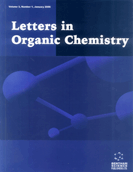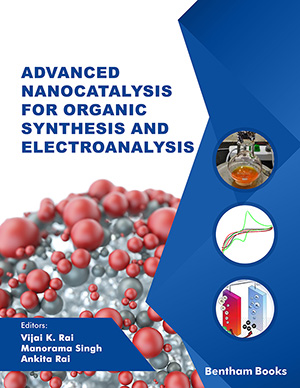Abstract
1,2-Dimethyl-3-methylsulfanylbenzene is the key intermediate of topramezone. This work designed a two-step continuous-flow device to synthesize 1,2-dimethyl-3- methylsulfanylbenzene via diazotization and methanethiolation. The results showed that compared with the batch process, the continuous-flow method greatly shortened the residence time to 1 minute, avoided the accumulation of large amounts of diazonium salts to reduce decomposition and increased the product yield to 91.7%. At the same time, the continuous- flow process improved the safety and efficiency of the reactions, saved reaction time and had good prospects for industrial application.
Keywords: Continuous-flow, diazotization, methanethiolation, topramezone, 1, 2-dimethyl-3-methylsulfanylbenzene, 2, 3-dimethylaniline.
[http://dx.doi.org/10.1002/ps.1341] [PMID: 17340675]
[http://dx.doi.org/10.1016/j.cropro.2021.105814]
[http://dx.doi.org/10.21273/HORTSCI.42.1.110]
[http://dx.doi.org/10.1016/j.cropro.2010.06.020]
[http://dx.doi.org/10.1614/WS-D-16-00001.1]
[http://dx.doi.org/10.1016/j.enzmictec.2020.109642] [PMID: 32912694]
[http://dx.doi.org/10.1016/j.ecoenv.2017.05.022] [PMID: 28525816]
[http://dx.doi.org/10.1016/j.heliyon.2019.e01712] [PMID: 31193336]
[http://dx.doi.org/10.2174/1568026615666150915111741] [PMID: 26369815]
[http://dx.doi.org/10.1007/s10870-015-0609-8]
[http://dx.doi.org/10.1002/ejoc.201900622]
[http://dx.doi.org/10.5012/jkcs.2012.56.6.716]
[http://dx.doi.org/10.5267/j.ccl.2012.6.002]
[http://dx.doi.org/10.1021/op025586j]
[http://dx.doi.org/10.1039/c3ob27366k] [PMID: 23358692]
[http://dx.doi.org/10.1016/S0040-6031(02)00100-4]
[http://dx.doi.org/10.1023/A:1020573723147]
[http://dx.doi.org/10.1016/j.tetlet.2006.06.024]
[http://dx.doi.org/10.1039/C5QO00037H]
[http://dx.doi.org/10.1021/acs.oprd.9b00286]
[http://dx.doi.org/10.1002/9780470988305.ch2]
[http://dx.doi.org/10.1039/B918763B] [PMID: 20023854]
[http://dx.doi.org/10.1021/op100327d]
[http://dx.doi.org/10.1002/chem.200305212] [PMID: 14673841]
[http://dx.doi.org/10.1002/chem.200600236] [PMID: 16832800]
[http://dx.doi.org/10.1007/s11030-010-9282-1] [PMID: 20960230]
[http://dx.doi.org/10.1055/s-0030-1259979]
[http://dx.doi.org/10.1039/c0cc05060a] [PMID: 21409184]
[http://dx.doi.org/10.1002/cssc.201100444] [PMID: 22275318]
[http://dx.doi.org/10.1002/tcr.201100041] [PMID: 22711555]
[http://dx.doi.org/10.3762/bjoc.9.314] [PMID: 24367443]
[http://dx.doi.org/10.1021/op4000169]
[http://dx.doi.org/10.1039/c3gc40195b]
[http://dx.doi.org/10.1002/anie.201307987] [PMID: 24402801]
[http://dx.doi.org/10.1021/op5001918]
[http://dx.doi.org/10.1039/C4GC00410H]
[http://dx.doi.org/10.1039/c1cs15075h] [PMID: 21826351]
[http://dx.doi.org/10.3762/bjoc.12.186] [PMID: 27829903]
[http://dx.doi.org/10.1039/C1GC16022B]
[http://dx.doi.org/10.1039/C3GC41942H]
[http://dx.doi.org/10.1002/ceat.200407128]
[http://dx.doi.org/10.1039/C8RE00252E] [PMID: 33456973]
[http://dx.doi.org/10.1021/acs.chemrev.7b00183] [PMID: 28570059]
[http://dx.doi.org/10.1039/c0sc00381f]
[http://dx.doi.org/10.1002/aic.14450]
[http://dx.doi.org/10.1016/j.ces.2017.08.020]
[http://dx.doi.org/10.1021/acs.oprd.7b00250]
[http://dx.doi.org/10.1021/acs.iecr.8b02839]
[http://dx.doi.org/10.1039/C8NJ01167B]
[http://dx.doi.org/10.1016/j.cej.2003.11.007]
[http://dx.doi.org/10.1002/ceat.200407122]
[http://dx.doi.org/10.1021/op200347k]
[http://dx.doi.org/10.1007/s11814-016-0114-6]
[http://dx.doi.org/10.1039/c3gc40374b]
[http://dx.doi.org/10.3762/bjoc.10.38] [PMID: 24605161]
[http://dx.doi.org/10.1007/s41981-018-0018-1]
[http://dx.doi.org/10.1039/B111286D] [PMID: 15100849]
[http://dx.doi.org/10.1556/jfchem.2012.00020]
[http://dx.doi.org/10.1021/op049789e]
[http://dx.doi.org/10.1016/j.cej.2021.130223]
[http://dx.doi.org/10.1021/acs.oprd.6b00238]
[http://dx.doi.org/10.1002/slct.202203577]
[http://dx.doi.org/10.1002/slct.202204997]
[http://dx.doi.org/10.1016/j.cep.2023.109295]
[http://dx.doi.org/10.1002/aic.11833]
[http://dx.doi.org/10.1039/C6RA23783E]
[http://dx.doi.org/10.1007/978-3-642-40872-4_2080-1]
[http://dx.doi.org/10.1016/j.partic.2021.03.005]
[http://dx.doi.org/10.1016/j.powtec.2018.08.036]
[http://dx.doi.org/10.1016/j.powtec.2017.07.011]
[http://dx.doi.org/10.1002/apj.2407]
[http://dx.doi.org/10.1016/j.watres.2020.116629] [PMID: 33249308]
[http://dx.doi.org/10.1021/jo9015248] [PMID: 19691326]
[http://dx.doi.org/10.1016/j.ica.2018.06.049]
[http://dx.doi.org/10.1016/j.saa.2018.11.033] [PMID: 30458391]
[http://dx.doi.org/10.1016/j.cep.2018.03.014]
[http://dx.doi.org/10.1021/acs.oprd.1c00144]
[http://dx.doi.org/10.1021/op300127x]
[http://dx.doi.org/10.1002/chem.201402092] [PMID: 24753266]


























